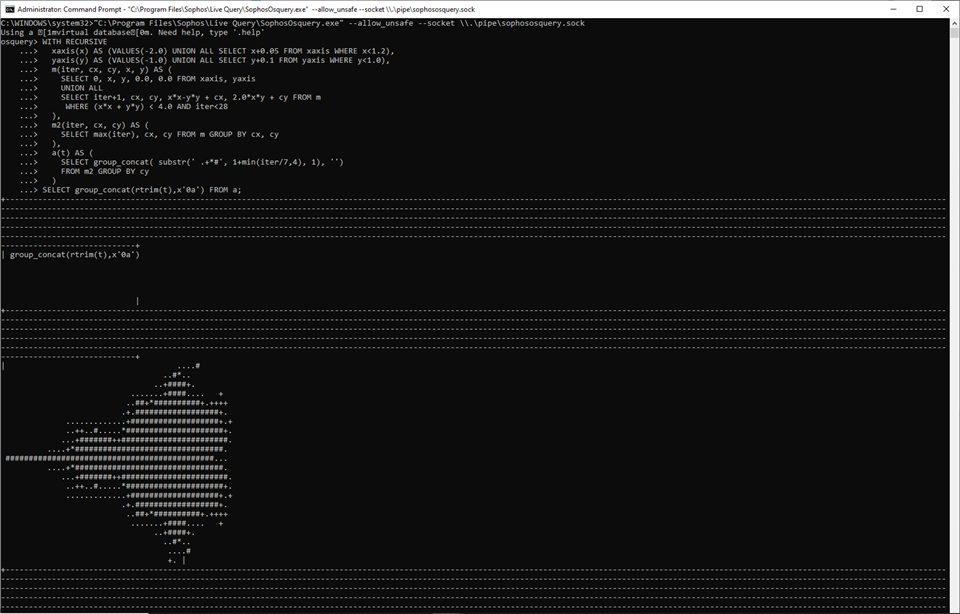Using the WITH and WITH RECURSIVE clause really opens up a lot of power. You can see recursion used with the Process Tree queries we published and the WITH clause in a number of other queries where we want to build some sort of temporary table that another select statement will join with. For a good set of examples and explanation of what is possible with SQLite you can simply search the internet with your favorite search engine.
https://sqlite.org/ has both a great detailed explanation of the statements available in sqlite (Most are available in Live Discover but not all) and some excellent examples.
For this one to run with the output the way it wants I had to start SophosOsquery.exe from a cmdshell. Below shows how to launch the SophosOsquery.exe and the Extension we use for journal access. Some folks find it easier to develop queries from the cmdline as opposed to from central.
Run CMD as admin
"C:\Program Files\Sophos\Live Query\SophosOsquery.exe" --allow_unsafe --socket \\.\pipe\sophososquery.sock
Run CMD as admin
"C:\Program Files\Sophos\Live Query\SophosOsqueryExtension.exe" --verbose --socket \\.\pipe\sophososquery.sock
then from the osquery prompt....
The following query computes an approximation of the Mandelbrot Set and outputs the result as ASCII-art:
WITH RECURSIVE
xaxis(x) AS (VALUES(-2.0) UNION ALL SELECT x+0.05 FROM xaxis WHERE x<1.2),
yaxis(y) AS (VALUES(-1.0) UNION ALL SELECT y+0.1 FROM yaxis WHERE y<1.0),
m(iter, cx, cy, x, y) AS (
SELECT 0, x, y, 0.0, 0.0 FROM xaxis, yaxis
UNION ALL
SELECT iter+1, cx, cy, x*x-y*y + cx, 2.0*x*y + cy FROM m
WHERE (x*x + y*y) < 4.0 AND iter<28
),
m2(iter, cx, cy) AS (
SELECT max(iter), cx, cy FROM m GROUP BY cx, cy
),
a(t) AS (
SELECT group_concat( substr(' .+*#', 1+min(iter/7,4), 1), '')
FROM m2 GROUP BY cy
)
SELECT group_concat(rtrim(t),x'1f') FROM a;
In this query, the "xaxis" and "yaxis" CTEs define the grid of points for which the Mandelbrot Set will be approximated. Each row in the "m(iter,cx,cy,x,y)" CTE means that after "iter" iterations, the Mandelbrot iteration starting at cx,cy has reached point x,y. The number of iterations in this example is limited to 28 (which severely limits the resolution of the computation, but is sufficient for low-resolution ASCII-art output). The "m2(iter,cx,cy)" CTE holds the maximum number of iterations reached when starting at point cx,cy. Finally, each row in the "a(t)" CTE holds a string which is a single line of the output ASCII-art. The SELECT statement at the end just queries the "a" CTE to retrieve all lines of ASCII-art, one by one.
Running the query above in an SQLite command-line shell results in the following output:
This thread was automatically locked due to age.

